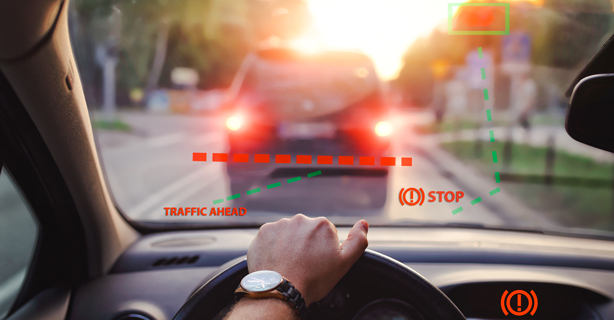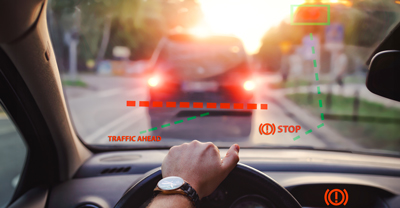A guide to vehicle safety features


When you're in the market for a new car, what matters most to you? Is it the make, the color, or the cost? Or perhaps, like many Americans, you prioritize safer driving and consider safety features first.
From advanced driver assistance systems (ADAS) to active safety technologies and crashworthiness ratings, safety features can bring peace of mind and enhance your overall driving experience. Our guide covers essential features, helping you prioritize safety without compromising on style or budget.
Why safety features matter
Every car ride carries an inherent risk, and that's where car safety features come into play. The advanced technologies, like automatic emergency braking and lane departure warnings, aren't just bells and whistles—they're your first line of defense, helping you avoid collisions altogether.
Safety features play a vital role in reducing the risk of injuries and their severity in a crash. Established technologies like seat belts (which can reduce the risk of death by 45% according to the National Highway Traffic Safety Administration) and airbags (offering a 29% reduction) continue to help save lives. Additionally, advanced driver-assistance systems provide further support for drivers.
This translates into peace of mind behind the wheel. Whether navigating bustling city streets or taking a long road trip, the knowledge that your car is equipped with these advancements allows you to focus on the journey—not potential dangers.

Request a free auto insurance quote.
Key safety features to consider in your next car
Safety technology has come a long way since the invention of the first headrest in 1921, designed to combat whiplash in rear-end collisions.
Advanced car safety features, such as automatic emergency braking and lane departure warning systems, are constantly being developed and can help prevent accidents and mitigate the severity of collisions. According to the National Highway Traffic Safety Administration (NHTSA), these features have played a significant role in reducing road fatalities in recent years.
As you navigate the car buying process, consider these essential safety features:
Collision avoidance systems
These systems use sensors and cameras to monitor your vehicle's surroundings, alerting you of potential collisions and even intervening to prevent accidents. Look for features such as forward collision warnings, lane departure warnings, and blind-spot monitoring.
Adaptive cruise control
This intelligent system adjusts your vehicle's speed to maintain a safe distance from the car ahead, reducing the risk of rear-end collisions. It's particularly beneficial for long highway drives, offering convenience and peace of mind.
Automatic emergency braking (AEB)
AEB is a groundbreaking technology that detects imminent collisions and automatically applies the brakes to help prevent or mitigate the impact. Whether it's a sudden stop from the vehicle in front or an unexpected obstacle, AEB can be a lifesaver in critical situations.
Pedestrian detection
Pedestrian safety becomes even more crucial as urban areas experience increasing congestion. Pedestrian detection systems use cameras and sensors to detect pedestrians in your vehicle's path, issuing warnings or applying brakes if necessary to prevent accidents.
Vehicle stability control (VSC)
VSC is designed to prevent skidding and loss of control during sudden maneuvers or adverse road conditions. By selectively applying brakes and adjusting engine power, VSC helps enhance stability and improve handling, especially in slippery or uneven terrain.
Advanced airbag systems
While airbags are a standard safety feature in most vehicles, advanced airbag systems offer enhanced protection. Look for vehicles with side curtain airbags, knee airbags, and seatbelt pretensioners to minimize the risk of injury in the event of a collision.
Backup cameras and parking assist
Parking-related accidents are all too common, but backup cameras and parking assist systems can help mitigate the risk. These features provide a clear view of your vehicle's surroundings, helping make parking and maneuvering in tight spaces safer and more efficient.
Tire pressure monitoring system (TPMS)
Proper tire maintenance is essential for vehicle safety, and TPMS helps ensure optimal tire pressure at all times. By alerting you to underinflated tires, TPMS helps reduce the risk of flat tires and improve overall vehicle performance.
Child safety features
If you have young passengers, prioritize vehicles with child safety features such as rear door child locks, LATCH (Lower Anchors and Tethers for Children) systems, and rear seat reminders. These features provide added protection and peace of mind for families on the road.
Crash test ratings
Before making a final decision, be sure to research the crash test ratings of your prospective vehicle. Organizations such as the NHTSA and the Insurance Institute for Highway Safety (IIHS) conduct rigorous crash tests and provide valuable insights into a vehicle's safety performance.

Start with a free auto insurance quote from Dairyland.
Safety features and auto insurance work together
In the realm of driving, safety is paramount. Safety features embedded within vehicles, whether it's antilock brakes or cutting-edge automatic emergency braking systems, are designed to help protect drivers and passengers. Yet, even with these advanced technologies, unforeseen incidents can still occur. That's where auto insurance steps in, offering an additional layer of protection.
At Dairyland®, a brand of the Sentry Insurance Group, we specialize in providing customizable and cost-effective auto insurance policies. With over seven decades of experience, we understand the importance of safeguarding both you and your vehicle on the road. Contact us today.
The general information in this blog is for informational or entertainment purposes only. View our blog disclaimer.
*Data accuracy is subject to this article's publication date.









